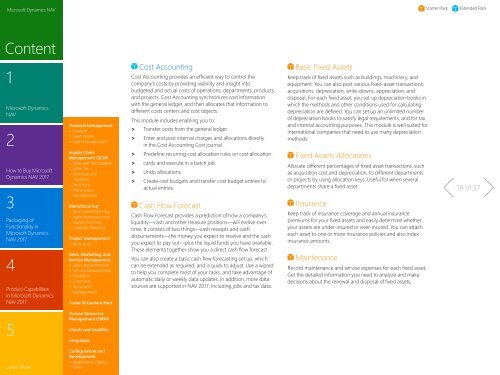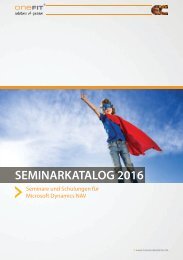DynamicsNAV_CapabilityGuide_EN
You also want an ePaper? Increase the reach of your titles
YUMPU automatically turns print PDFs into web optimized ePapers that Google loves.
Microsoft Dynamics NAV<br />
Starter Pack<br />
Extended Pack<br />
Content<br />
1<br />
Microsoft Dynamics<br />
NAV<br />
2<br />
How to Buy Microsoft<br />
Dynamics NAV 2017<br />
3<br />
Packaging of<br />
Functionality in<br />
Microsoft Dynamics<br />
NAV 2017<br />
4<br />
Product Capabilities<br />
in Microsoft Dynamics<br />
NAV 2017<br />
Financial Management<br />
> General<br />
> Fixed Assets<br />
> Cash Management<br />
Supply Chain<br />
Management (SCM)<br />
> Sales and Receivables<br />
> Sales Tax<br />
> Purchase and<br />
Payables<br />
> Inventory<br />
> Warehouse<br />
Management<br />
Manufacturing<br />
> Basic Manufacturing<br />
> Agile Manufacturing<br />
> Supply Planning<br />
> Capacity Planning<br />
Project Management<br />
> Resources<br />
Sales, Marketing, and<br />
Service Management<br />
> Sales and Marketing<br />
> Service Management<br />
> Worklow<br />
> E-services<br />
> Document<br />
Management<br />
Power BI Content Pack<br />
Cost Accounting<br />
Cost Accounting provides an eficient way to control the<br />
company’s costs by providing visibility and insight into<br />
budgeted and actual costs of operations, departments, products,<br />
and projects. Cost Accounting synchronizes cost information<br />
with the general ledger, and then allocates that information to<br />
different costs centers and cost objects.<br />
This module includes enabling you to:<br />
> Transfer costs from the general ledger.<br />
> Enter and post internal charges and allocations directly<br />
in the Cost Accounting Cost journal.<br />
> Predeine recurring cost allocation rules on cost allocation<br />
> cards and execute in a batch job.<br />
> Undo allocations.<br />
> Create cost budgets and transfer cost budget entries to<br />
actual entries.<br />
Cash Flow Forecast<br />
Cash Flow Forecast provides a prediction of how a company’s<br />
liquidity—cash and other treasure positions—will evolve over<br />
time. It consists of two things—cash receipts and cash<br />
disbursements—the money you expect to receive and the cash<br />
you expect to pay out—plus the liquid funds you have available.<br />
These elements together show you a direct cash low forecast.<br />
You can also create a basic cash low forecasting set up, which<br />
can be extended as required, and is quick to adjust. Use a wizard<br />
to help you complete most of your tasks, and take advantage of<br />
automatic daily or weekly data updates. In addition, more data<br />
sources are supported in NAV 2017, including jobs and tax data.<br />
Basic Fixed Assets<br />
Keep track of ixed assets such as buildings, machinery, and<br />
equipment. You can also post various ixed-asset transactions:<br />
acquisitions, depreciation, write-downs, appreciation, and<br />
disposal. For each ixed asset, you set up depreciation books in<br />
which the methods and other conditions used for calculating<br />
depreciation are deined. You can set up an unlimited number<br />
of depreciation books to satisfy legal requirements, and for tax<br />
and internal accounting purposes. This module is well suited for<br />
international companies that need to use many depreciation<br />
methods.<br />
Fixed Assets Allocations<br />
Allocate different percentages of ixed asset transactions, such<br />
as acquisition cost and depreciation, to different departments<br />
or projects by using allocation keys. Useful for when several<br />
departments share a ixed asset.<br />
Insurance<br />
Keep track of insurance coverage and annual insurance<br />
premiums for your ixed assets and easily determine whether<br />
your assets are under-insured or over-insured. You can attach<br />
each asset to one or more insurance policies and also index<br />
insurance amounts.<br />
Maintenance<br />
Record maintenance and service expenses for each ixed asset.<br />
Get the detailed information you need to analyze and make<br />
decisions about the renewal and disposal of ixed assets.<br />
16 of 37<br />
5<br />
Human Resources<br />
Management (HRM)<br />
Clients and Usability<br />
Languages<br />
Learn More<br />
Coniguration and<br />
Development<br />
> Application Objects<br />
> Other








